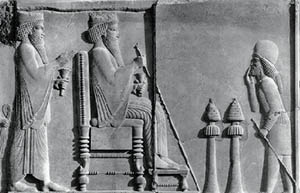




On most holidays, children make do with candies and nuts, but on Purim and Chanukah they can look forward to actual gelt, whether as gifts or as rewards for delivering mishloach manot. Purim has a history with money, going back to the beginning. Haman said to Achashverosh, “I will pay 10,000 talents of silver to the king’s treasury” (Esther III, verse 9). Those coins must have been the ‘SiGLos’ (a form of SheKeL) that were the early and main currency of Persia. They were struck in silver (and gold, called a Daric after Darius) and always depict the great king of Persia holding a bow and spear or dagger. [figure 1]
They were minted for 200 years before, during and after the Purim story. Interestingly, the best preserved ones weigh about 5.5 grams, exactly half a shekel’s weight during the First Temple period and into the early Second Temple. So they would be perfect for paying Machatzit Hashekel. Persian coins circulated throughout their empire, including as far west as Eretz Yisrael and Asia Minor.
Another Persian-period coin pictures the king sitting on his throne. (“At that time, as King Achashverosh sat on his royal throne in Shushan the capital” 1:2 and “…the king was sitting on his throne in the royal palace…” 5:1). Furthermore, he is holding a long scepter! (“…The king extended to Esther the golden scepter which was in his hand…” 5:2 and “…the king extended to Esther the golden scepter…” 8:4). [figure 2]
The image on the coin is remarkably similar to surviving stone wall reliefs in the Persian city of Persepolis (illustrated in Yehuda Landy’s book on page 82). The king Xerxes is pictured with a long beard, bushy hair behind and a crown. He holds a long scepter in his right hand and a lotus flower in his left. [figure 3]
These coins were minted in Eretz Yisrael and surrounding provinces, among the 127 of the Persian empire. They are tiny, weighing only half a gram.
Additional coins were struck in Eretz Yisrael under the Persians. This next example is also tiny, but carefully engraved and well-struck. One side shows a crowned head. We see resemblance to the Persian king in the depiction of the crown and the thick hair behind his head (although not much of a beard here). [figure 4]
The other side shows an eagle. More interestingly, there is an inscription – YHD – in ancient First Temple Hebrew, on the left side. [figure 5]
This group of coins is called “Yehud” coins. And Yehud (Medinta) was the name of Eretz Yisrael as a province under the Persians (see Ezra 5:8). Thus we find Mordechai identified as ‘Ish Yehudi’ (Esther 2:5) because he was known to be from that place, even though he was “Ish Yemini,” from the tribe of Binyamin.
These bits of silver take us back to the time and place of the Megillah story, for they were actually there. They are tangible remains and reminders of our history.
By Rabbi Binyamin Yablok
Rabbi Yablok speaks to schools and synagogues on a variety of Jewish topics, all illustrated with original artifacts. He can be reached at [email protected].








